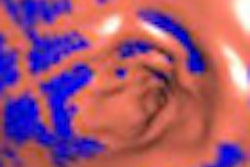
Despite the recent release of court transcripts from the Mad River CT overdose case, questions still remain as to how a Northern California radiologic technologist (RT) performed 151 CT scans on a 2-year-old boy in 68 minutes -- resulting in a massive radiation overdose.
In a case that has shocked the radiology community, 2-year-old Jacoby Roth was scanned repeatedly at Mad River Community Hospital in Arcata, a small community 290 miles north of San Francisco. Many experts have struggled to understand how the overexposure could have occurred despite procedures and equipment design features intended to prevent such incidents.
Newly released court documents from a disciplinary hearing for the technologist involved, Raven Knickerbocker, provide additional insight into just what happened in Mad River's CT suite the morning of January 23, 2008. But while Knickerbocker explains how she performed the scans that day, she still appears baffled that the procedure resulted in such a massive radiation overdose.
Transcripts made available
After the incident, Knickerbocker was fired by the hospital and her license was suspended following hearings held by the California Department of Public Health (CDPH). She appealed the suspension, and her explanation of the incident came during hearings held in March 2010 in Sacramento, CA, to review her license. A transcript of the hearings was recently released following a reporter's inquiry.
In describing to the court her education and training, Knickerbocker said she received an associate of applied sciences degree in radiography from Pima Medical Institute in Albuquerque, NM. She received her RT's license in 2000, and by the time the Roth exams occurred she had performed more than 100 pediatric scans, including cervical spine exams.
Prior to the hearing, she had maintained her certification with the American Registry of Radiologic Technologists (ARRT) and had taken additional training in mammography, fluoroscopy, forensic radiology, and radiation physics. She had worked at various imaging facilities, from level I trauma centers to the clinic attached to the stadium used by the San Francisco Giants baseball team.
In her testimony, Knickerbocker described in detail the functions of the CT scanner that was used to scan Roth, a Picker PQ 5000 model commonly sold in the late 1990s by Picker International, a multimodality imaging firm acquired by Philips Healthcare of Andover, MA, in 2001. She was familiar with the system from previous experience with the model and had even trained other Mad River employees in the use of the system, she said.
A fall from bed
The documents indicate that Roth was taken to Mad River's emergency room after he fell out of bed and had difficulty moving his head. The ER doctor ordered x-rays and CT scans to check for damage to the boy's cervical spine.
The child was taken to the scanning room, where Knickerbocker performed CT scans at C-spine levels C1 through C4 in the same section of the midmaxillary sinuses, midclivus, and posterior fossa. Knickerbocker told the court that she started the boy's scan by programming the CT scanner to acquire axial images. Roth's mother, Carrie Roth, was with Knickerbocker in the control room, while the boy's father, Padre Roth, remained with him in the scanning suite.
Carrie Roth asked Knickerbocker about the amount of radiation her son would receive, checking to see if the scan was necessary because she was concerned that the boy had received a prior CT head exam.
"She was asking me about dose amount, and I explained to her that I couldn't provide her with an exact dose amount," Knickerbocker said. "That wasn't my job description, and she also began asking me if it was common for us to perform these types of exams on children of this age at this facility."
Knickerbocker reassured the mother by telling her that CT scans were commonly performed on children who had fallen and that she was experienced in CT scanning, she said.
Knickerbocker programmed the scanner by adjusting its protocols for a child-sized body, decreasing the kV and mA below what was standard for an adult, according to the court transcript. She then acquired a scout image before setting the beginning and end points of the scan, with the first slice beginning above the base of the boy's skull.
After acquiring two axial images, she started receiving error messages from the scanner, Knickerbocker said. "I got two images -- axial images that appeared one after another on the large blue screen, one image at a time. And then I -- on the touch panel I was flashed that there was a table error followed by a series of numbers," she told the court.
She verified that the table height was "within normal range," she said. "I shouldn't have gotten an error for that," Knickerbocker recalled.
She also went into the scanning room and asked the boy's father, who had been trying to soothe his son, not to lean against the patient table, saying she thought that might have been the problem. After she returned to the control room, the table error had cleared.
"I selected the resume imaging of my exam and hit the expose button again," Knickerbocker said. One image appeared, but then the machine stopped and flashed another error code, displaying that only the axial mode was available, she recalled. She was using the CT scanner's advanced dynamic scanning (ADS) mode during the procedure, she said.
"In response to that message, I backed out and attempted to perform the exam in the axial mode like the computer asked," Knickerbocker explained. "In the past I've been able to do that; after you initiate the axial mode, you can kind of go in the back door and hit the ADS button again on the touchscreen panel, then from that point on tie the rest of your images together and proceed as usual."
She tried to initiate the images manually "once or twice," Knickerbocker said. To get the test moving again, she tried "to kind of backdoor it and initialize a couple of manual axial images and then jump-start the ADS and continue with the examination," she told the court.
She then called another technologist for advice, who told her to shut down the system. Then, she restarted the exam, Knickerbocker said.
"I had three errors -- the table error, then I had the axial error, then when that wasn't working I got a third error that was just a bunch of numbers. So I attempted another work-around that we call a soft start," Knickerbocker said. "You basically back out to where you have no information of your exam except patient information, and then basically reprogram the entire exam and tell it, I want to do child C-spine 3-millimeter slices at 2-millimeter intervals with this mA and this kV. I had to re-enter everything."
After re-entering the information, she said the scanner would not let her initiate the ADS.
Knickerbocker said she then started looking for the machine's manual and recalled the boy's father growing "increasingly impatient."
She then shut off the power to the scanner and shut everything down, according to the transcript.
Massive radiation overdose
Within a few hours, Roth developed a bright red ring around his head from the massive radiation overdose. Photographs of the left side of the boy's face show a clear line extending from the infraorbital ridge backward through the ear and nape of the neck; a similar line extends from the infraorbital ridge through the ear on the right side.
Knickerbocker said she didn't learn of the overdose until later in the day, and it wasn't until Mad River terminated her employment that she learned that the hospital had charged her with performing 151 scans on Roth. During a previous hearing, Carrie Roth had testified that she saw Knickerbocker push the scan button many times, about every 30 seconds, and scanner records indicate an average interval of 25 seconds between each of the 151 scans.
But Knickerbocker claimed she only pushed the scan button about a half-dozen times.
"I was upset because I didn't understand how there could have been an overexposure when I had taken about six images," she said.
Knickerbocker said she was more upset about possibly hurting the child. "I was more upset about the fact that it was believed that I would do this to a pediatric patient or any patient for that matter," she told the court. "That was my main concern, that there was an injury -- a potential injury created by myself."
She denied being so distracted by the boy's parents that she didn't realize how many times she had pushed the scanner button. "Absolutely not to the point that I would push a button 151 times," Knickerbocker testified.
Toward the end of the testimony, Knickerbocker was asked if she had seen the 151 images that resulted from the Roth examination, which were entered as an exhibit in the hearing. Knickerbocker said the scout image and the first few images looked familiar, as she saw them on the monitor during the study, but she had not seen the 151 images in their entirety until she reviewed them with counsel.
She added that Mad River later went back and made modifications to the scanner's monitor so that technologists would always be aware of how many images had been taken by displaying a time stamp, an image number, and couch incrementation.
Although Knickerbocker said she felt remorse for what happened to the child, she steadfastly refused to accept responsibility for the overdose: "I cannot accept responsibility for something I did not do," she stated.
When asked to explain the 151 images taken of the boy, she was at a loss. "The only explanation I can think of is a mechanical error or some kind of programming error through the computer where the machine is assuming and performing an exam that I didn't ask it to do," she told the judge. The judge then pointed out that Knickerbocker had programmed the scanner herself.
Knickerbocker was also asked if she had ever experienced a situation in which she programmed a machine in a way that it would continue to take images when the technologist did not think they were being taken. Knickerbocker replied that she'd never seen anything like that happen before.
Well-publicized incidents
The Mad River case is one of several well-publicized incidents of radiation overdose that have prompted federal lawmakers and regulatory authorities to examine the regulation of medical radiation more closely.
Recent efforts to deal with the medical radiation crisis are focusing on reducing the chances of operator error and making imaging professionals more aware of the dose that patients are receiving at time of the scan.
Such warnings would have prevented overdose cases like the one at Mad River, as well as a case at Cedars-Sinai Medical Center in Los Angeles where as many as 260 patients may have received up to eight times the standard radiation dose for CT brain perfusion scans at the facility from 2008 to 2009. Several medical malpractice lawsuits have been filed against Cedars-Sinai in the aftermath. In the Mad River case, Roth's parents reached a confidential settlement in May with the hospital.
Also in May, the California Senate passed legislation designed to protect patients from excess medical radiation through measures such as recording the radiation dose from CT scans, and the bill is working its way through the state Assembly. The legislation requires radiation dose levels to be recorded on CT images and in a patient's health records.
Knickerbocker knows that her career in radiology is probably over, but she insists that she meant no harm. "This is going to follow me the rest of my life regardless of what I do," she said in the hearing. "I wouldn't want to put anyone at risk. I went into this field to help people, not to hurt anybody."
By Donna Domino
AuntMinnie.com staff writer
July 1, 2010
Related Reading
Settlement reached in Mad River pediatric CT radiation case, May 24, 2010
California RT gives deposition in CT overdose case, December 10, 2009
California technologist faces testimony in CT overdose case, September 18, 2009
California hospital fined $25,000 for pediatric CT radiation overdose, March 24, 2009
Parents sue California hospital over CT radiation dose, November 20, 2008
Copyright © 2010 AuntMinnie.com




















